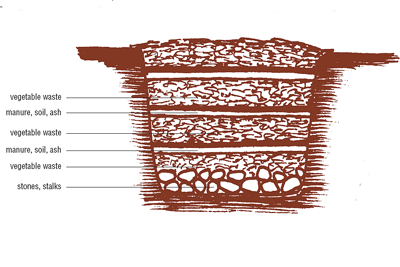by Peter Musgrave.
Compost-making is a vital, life-saving opportunity to save waste and turn it into productive use. Compost is made from mixing together organic waste materials – such as leaves, weed and straw – and leaving them to decompose until a black, crumbly soil is formed. The materials needed to make it are locally available, accessible and free.
Mature compost helps plants to grow better. It enriches soil, which loses nutrients to food-hungry plants. By using compost, people can grow more vegetables and trees to feed themselves. Composting simply copies nature’s ways. Leaves fall from trees, plants grow and die and the natural cycle of decay returns nutrients to the soil. Many people know about compost, but they don’t take time to make it in an organised way. Many farmers instead rely on chemical fertilisers. However, these are expensive and do not improve soil structure.
We read in the Bible of God’s care of nature. For example, Psalm 65 reminds us that God cares about the earth, especially the fertile soil. God created everything that exists. However, there is a taboo in many cultures about touching ‘dirty things’ like compost and cow dung, and education may reinforce this idea. For many people, the purpose of schooling in Bangladesh is to enable children to get off the land into ‘clean’ jobs. So, how does God view the dirt?
In the Bible, poor and humble people are lifted high. Dirt and cow dung are at the heart of the Christmas message! The ‘dirty’ shepherds in the fields at night are the first to be told about the Christ Child. They find the baby wrapped in a blanket, lying in a manger, (a cow’s food trough). The message for us too, as farmers, people on the margins or of low caste, is to look among the poor to see God at work in the world.
Producing compost
Compost can be made from any available plant waste, including rice straw and water hyacinth.
Water hyacinth clogs up the water channels all over Bangladesh and is a real problem. However, if chopped up and put into compost heaps it quickly rots down and produces excellent compost. It can also just be left to rot on the fields and enrich the soil for the next crop.
Farmers near Jobarpar and Bisherkandi have learned to make balls of compost from rotted water hyacinth. They plant tree seedlings into the balls and find them popular to sell to people in the market.
Compost pits and heaps
In wet areas it is recommended to build compost heaps above the ground. In dry areas, compost pits can be dug. Pits or heaps should be around one square metre in size. For heaps, make a framework from wooden stakes and branches on three sides. Make a base of stones or stalks for drainage. Fill the pits or heaps with layers of dead leaves, green weeds, straw, soil, manure, kitchen waste and ash from cooking fires.
Three pits or heaps are recommended. New material for composting is added to one heap or pit and then moved to another heap or pit every two weeks to add air, mix up the materials and speed up the rotting process. Water is also added. Finished compost that is ready to use can be stored in the third heap or pit. Cover with plastic or matting to protect the compost from sun and rain and to prevent the loss of plant nutrients. The waste material has been changed into something new, productive and useful – black gold!
Peter Musgrave worked with the Church of Bangladesh for five years. His address is: 3 Auckland Rd, Ilford, Essex, IG1 4SD, UK. Tel/Fax: +44 (0)20 8554 0923 E-mail: [email protected]
Diagram showing the layers in a typical compost pit.










